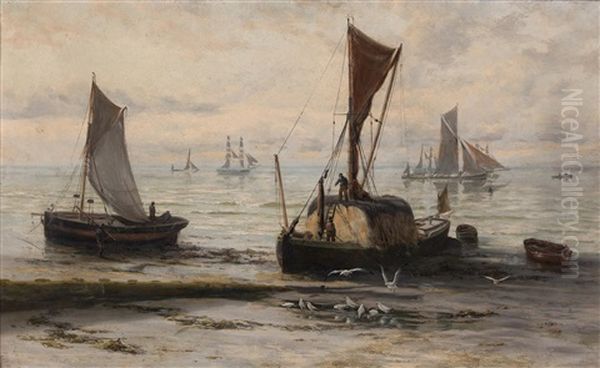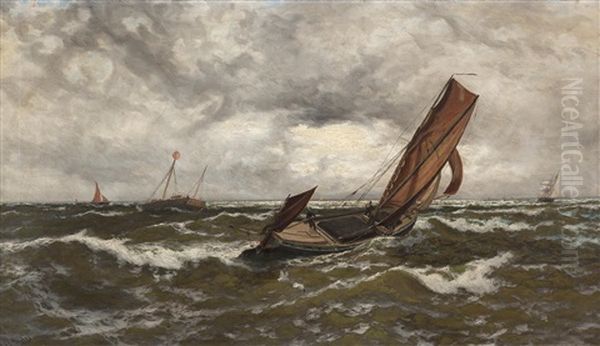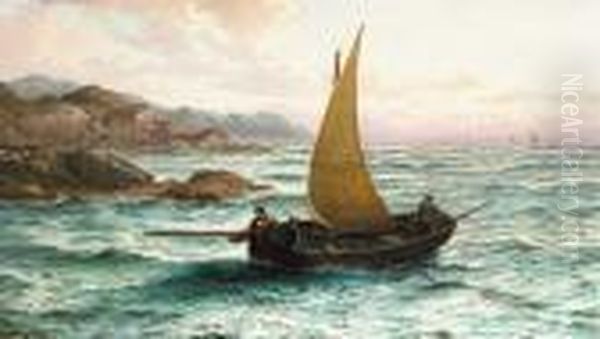Thomas Rose Miles stands as a notable figure in British art from the late 19th and early 20th centuries. An accomplished painter, he dedicated his career primarily to capturing the dynamic relationship between humanity and the sea, focusing on the landscapes, marine scenes, and working lives found along the coasts of Britain and Ireland. His works resonated particularly with those familiar with maritime life, earning him recognition during his lifetime through exhibitions at prestigious institutions. While details of his personal life remain somewhat elusive, his paintings offer a compelling visual record of a specific time and place.
Biographical Uncertainties
Pinpointing the exact lifespan of Thomas Rose Miles presents a challenge, as historical records and the information provided offer conflicting dates. Some sources suggest he was born in 1869 and died in 1910. However, other art historical references, often considered more reliable for artists of this period, place his dates as approximately 1844 to 1916. This discrepancy makes definitive biographical statements difficult. One source even erroneously listed a death date of 1820, which is clearly incorrect given his documented exhibition history in the late 19th and early 20th centuries.
Further complicating a detailed biographical sketch is the scarcity of information regarding his early life, upbringing, and formal artistic training. While his exhibition record confirms his status as a professional artist active within established art circles, the specific path he took to develop his skills – whether through formal academy training, apprenticeship, or self-teaching – is not clearly documented in readily available sources. What remains clear is his dedication to his craft and his focus on specific themes throughout his active years.
Artistic Focus: Seascapes and Landscapes
The core of Thomas Rose Miles's artistic output lies in his evocative depictions of coastal and marine environments. He possessed a keen eye for the nuances of the sea, the sky, and the land where they meet. His favoured subjects often included the harbours, beaches, and rugged coastlines of Great Britain and Ireland. He seemed particularly drawn to the atmospheric conditions of these locations, capturing the changing light, the drama of approaching storms, or the relative calm of an evening tide.

His geographical focus often centred on areas like the northeast coast of England, known for its busy ports and fishing industries. Works such as Early Evening, Southend Sands and Bound for the Thames clearly indicate his interest in the Thames Estuary region. He also frequently painted scenes in Ireland, particularly around Galway Bay and Connemara. Titles like Galway Bay from Knock-na-Carra and Fishers Returning, Morning at Stone Head, Connemara attest to his time spent capturing the unique landscapes and maritime activities of the Irish west coast.
Miles's landscapes and seascapes were more than just topographical records; they aimed to convey the mood and feeling of the place. He explored the interplay of light on water, the textures of rock and sand, and the vastness of the sea. Whether depicting bustling harbour activity or more isolated stretches of coastline, his work consistently reflects a deep engagement with the maritime world.
The Human Element: Labour and Resilience
A defining characteristic of Thomas Rose Miles's work is the frequent inclusion of human figures, grounding his landscapes and seascapes in lived experience. He rarely depicted deserted coasts; instead, his scenes are often populated by individuals engaged in their daily lives and labour, particularly those connected to the sea. Fishermen mending nets, launching boats, navigating choppy waters, or returning with their catch are recurring motifs.
Miles seemed particularly interested in portraying the working class, especially dock workers and fishing communities. His paintings often highlight the demanding nature of their occupations and their relationship with the powerful forces of nature. There's a sense of respect and empathy in his portrayal, capturing moments of toil, camaraderie, and quiet endurance. It was noted that his depictions of the bravery and spirit of workers facing challenges resonated strongly with these communities themselves, contributing to his popularity among them.
His representative work, often cited as The Storm is Coming On, Gower Bay (though sometimes listed with Galway Bay, suggesting possible confusion or variations), exemplifies this focus. It reportedly depicts fishermen working near a rocky inlet while figures on shore watch with concern as a storm approaches. This narrative element, combining landscape, marine drama, and human emotion, is characteristic of his approach, elevating his work beyond simple observation to a commentary on the human condition within the maritime environment.
Exhibition History and Recognition

Thomas Rose Miles achieved considerable recognition within the established art world of his time, evidenced by his consistent participation in major exhibitions. His work was accepted and shown at some of the most prestigious venues in the United Kingdom and Ireland. Chief among these was the Royal Academy of Arts in London, the premier art institution in Britain. Exhibiting at the RA Summer Exhibition was a significant mark of professional standing for any artist.
He also frequently exhibited with the Society of British Artists (SBA, later Royal Society of British Artists, RBA), another important London-based society providing a platform for artists outside the stricter confines of the RA. His reach extended beyond London, with works shown at the Royal Scottish Academy (RSA) in Edinburgh and the Royal Hibernian Academy (RHA) in Dublin. This indicates a national reputation and an engagement with the art scenes across the British Isles.
Furthermore, Miles exhibited his work through commercial galleries, notably Arthur Tooth & Sons in London. This gallery was a well-regarded establishment dealing in contemporary British and European art, suggesting Miles had achieved a level of commercial viability and critical acceptance that allowed him access to the art market. This consistent exhibition record across multiple high-profile venues underscores his active participation and recognized status within the professional art community of the late Victorian and Edwardian eras.
Artistic Style and Technique
Stylistically, Thomas Rose Miles worked within the broad tradition of British landscape and marine painting prevalent in the late 19th and early 20th centuries. His approach generally leaned towards realism, aiming for a convincing representation of the scenes he observed. He worked primarily in oils, a medium well-suited to capturing the textures, light effects, and atmospheric conditions inherent in his chosen subjects.
His marine paintings likely demonstrated a strong understanding of naval architecture and the behaviour of ships and boats in various sea conditions, a hallmark of quality marine art. His handling of light would have been crucial, whether depicting the bright clarity of a calm day, the diffused light of an overcast sky, or the dramatic contrasts found in stormy weather. The rendering of water itself – its transparency, reflections, and movement – would have been a key focus of his technique.

While not generally associated with avant-garde movements like Impressionism, which was developing concurrently, his work might show subtle influences in terms of capturing fleeting light effects or a slightly looser brushwork compared to earlier Victorian academic styles. However, the core of his style remained rooted in realistic observation, detailed rendering where necessary (especially in depicting boats or figures), and a strong sense of place and atmosphere, often imbued with a narrative or emotional undertone related to the human activities portrayed.
Context: Contemporaries and Influences
Thomas Rose Miles worked during a vibrant period in British art, alongside numerous other artists exploring similar themes of landscape, marine life, and social observation. Placing him in context requires looking at contemporaries who shared his interests or represented the broader artistic landscape of the time.
One direct contemporary mentioned in the source material is Thomas Miles Richardson Jr. (1813-1890). While sharing a surname and an interest in landscape, Richardson was known more for his watercolours and his depictions of Scotland, the Lake District, and continental Europe, representing a slightly earlier generation and a different technical focus.
More direct comparisons can be drawn with leading marine painters of the era. William Lionel Wyllie (1851-1931) was a pre-eminent painter and etcher of maritime and river scenes, particularly the Thames and naval subjects, known for his atmospheric accuracy. Charles Napier Hemy (1841-1917) was another significant marine artist, often painting coastal scenes with fishing boats and dramatic seas, sometimes working from a floating studio. Although slightly later, Montague Dawson (1890-1973) became hugely popular for his dramatic paintings of sailing ships, carrying the tradition of marine art into the mid-20th century.
In landscape painting, Miles's contemporaries included figures like Benjamin Williams Leader (1831-1923), immensely popular for his picturesque views of the English and Welsh countryside, often featuring silvery birch trees and reflective water. John Atkinson Grimshaw (1836-1893) specialised in evocative moonlit scenes of urban streets and docks, sharing Miles's interest in harbours, albeit with a different atmospheric focus. The Pre-Raphaelite associate John Brett (1831-1902) also painted highly detailed coastal and sea views earlier in the period.
The focus on working life in Miles's paintings connects him thematically to artists associated with British Social Realism. Figures like Sir Hubert von Herkomer (1849-1914), Frank Holl (1845-1888), and Sir Luke Fildes (1843-1927) tackled subjects of poverty, labour, and social conditions, though often in more overtly narrative or urban contexts. Miles's work shares their interest in the lives of ordinary people but places it firmly within the coastal and maritime setting.
Given his exhibitions in Scotland and Ireland, relevant contemporaries there include William McTaggart (1835-1910), a Scottish painter renowned for his expressive seascapes, and Irish artists like Walter Osborne (1859-1903) or Nathaniel Hone the Younger (1831-1917), both known for their landscape and genre scenes capturing Irish life and light. While no direct collaborations are documented, Miles operated within this rich and varied artistic milieu.
Market and Legacy
Thomas Rose Miles's paintings continue to appear on the art market, indicating sustained interest among collectors of British traditional art. Auction records show a relatively steady stream of his works becoming available over the years. As noted in the provided information, the prices achieved can vary considerably, reflecting factors common to the art market.
The value of a specific Miles painting depends on several elements. Size and condition are always important considerations. The subject matter also plays a role; dramatic marine scenes or well-populated harbour views might command higher prices than simpler landscapes. Provenance, or the history of ownership, can add value, as can exhibition history if a painting was shown at a major venue like the Royal Academy during the artist's lifetime. The estimates provided (€800-€1200 for Early Evening, Southend Sands, €1500-€2500 for Bound for the Thames, €2000-€3000 for Fishers Returning, Morning at Stone Head, Connemara) illustrate this range.
His legacy rests on his contribution to British marine and landscape painting. He captured specific locations, particularly the coasts of Northeast England and Western Ireland, at a time of significant social and industrial change. His focus on the lives of fishermen and dock workers provides a valuable social document, portraying their labour with dignity and realism. While perhaps not an innovator who drastically changed the course of art history, he was a skilled and sensitive painter who recorded his world with dedication.
Conclusion
Thomas Rose Miles remains a figure of interest within British art history, primarily for his evocative and atmospheric paintings of coastal life. Despite the frustrating uncertainties surrounding his precise dates and personal biography, his artistic output speaks for itself. Through numerous canvases, he explored the beauty and power of the sea, the specific character of British and Irish coastlines, and the daily realities of the people who lived and worked alongside the water. His regular exhibitions at major institutions confirm his professional standing, and the continued presence of his work on the art market indicates an enduring appreciation for his skillful and empathetic portrayal of the maritime world. He offers a window onto the late Victorian and Edwardian eras, capturing the enduring relationship between humanity and the sea with honesty and artistic skill.